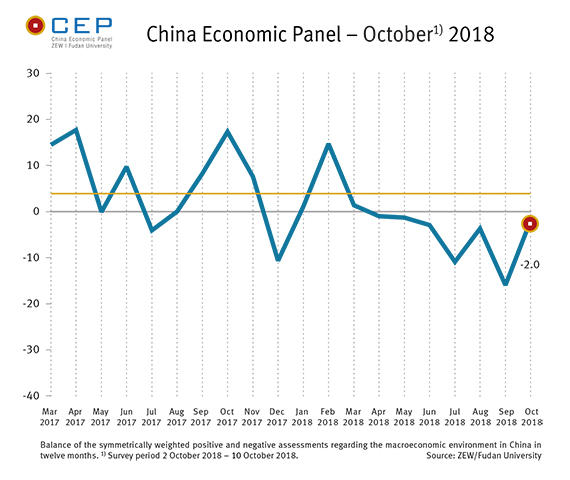Economic Expectations for China Rise, but Uncertainty Remains
China Economic PanelIn the most recent survey for October (02/10/2018–17/10/2018), expectations regarding the Chinese economy rose again. The CEP Indicator, which reflects the expectations of international financial market experts regarding China’s macroeconomic development over the coming twelve months, has climbed 14 points to a current reading of minus 2.0 points (September 2018: minus 16.0 points). The indicator thus still remains well below the long-term average of 3.9 points. Falling 5.7 points to a level of minus 3.9 points, the assessment of the current economic situation in China was more negative than the previous month.
“Although the CEP indicator rose in October, it still remains on a relatively low level. Also, with the economic situation being assessed more negatively, this suggests a less favourable outlook for China’s economic growth over the next twelve months,” says Dr. Michael Schröder, senior researcher in the ZEW Research Department “International Finance and Financial Management” and project leader of the CEP survey.
The latest economic figures from the National Bureau of Statistics of China show that real GDP growth fell slightly – to 6.5 per cent – in the third quarter compared with the previous year. In the near future, the participants of the CEP survey expect to see a further slowdown in real GDP growth, with the predicted growth rates for the first quarter of 2019 being 6.4 per cent, and for the whole of 2019 even as low as 6.3 per cent.
Trade dispute with the US evident in import expectations
Although China’s exports have been assessed more favourably compared to September, at minus 4.2 points, the corresponding indicator still remains in negative territory. The expectations for China’s share of world trade have decreased by 11.9 points to a level of 0.1 points. The negative effects of the trade dispute with the US are particularly evident in import expectations, with the corresponding indicator falling 22.9 points to a reading of minus 20.9 points. This is based on the forecast that there will be a reduced demand by companies and private households for foreign goods as a result of customs-related price increases.
“This relatively high volatility of the CEP indicator as well as of expectations regarding other economic factors shows that sensitivity is high with respect to developments in the trade dispute with the US. Since positions in the trading dispute are highly changeable, expectations have become more volatile, which in turn reflects the current uncertainty among experts,” explains Michael Schröder.
For more information please contact
Dr. Michael Schröder, Phone: +49 (0)621-1235-368, E-mail: michael.schroeder@zew.de
